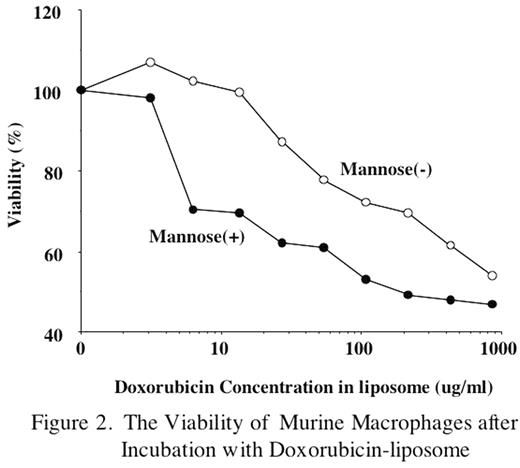Abstract
Immune thrombocytopenic purpura (ITP) is an autoimuune disease in which platelet antibodies cause increased platelet consumption. The destruction of platelets is mediated by the reticuloendothelial system (RES), especially hepatic and splenic macrophages. The depletion of these cells was carried out by the intravenous injection of mannose labeled liposome-encapsulated doxorubicin (mannose-DXR-liposome). The reason why mannose labeled liposome was used was that the macrophage expressed mannose receptor on the surface. Therefore, mannose-DXR-liposome is considered to be phagocyted specifically by macrophages. In this study, we evaluated the effects of mannose-DXR-liposome in a mouse model of ITP.
In vitro experiments: Murine peritoneal macrophages were obtained by the intraperitoneal injection of thioglycolate (TGC) to ddY mice.
The uptake of fluorescence by peritoneal macrophages was measured using rhodamine-liposome by flow cytometry. The macrophages were incubated with mannose labeled rhodamine-liposome (mannose(+)-rhodamine-liposome) or mannose unlabeled rhodamine-liposome (mannose(−)-rhodamine-liposome) for 30 min at 37 °C. After washing with PBS, they were applied for flow cytometry. Rhodamine fluorescence intensity in macrophages was higher in mannose(+)-rhodamine-liposome treatment than that in mannose(−)-rhodamine-liposome treatment (Figure 1).
The viability of peritoneal macrophages was measured by MTT assay after 30 min incubation with DXR-liposome. The viability in the treatment with mannose(+)-DXR-liposome was much less than that in the treatment with mannose(−)-DXR-liposome (Figure 2).
In vivo experiment: Anti-mouse platelet serum (APS) was injected intraperitoneally to ddY mice at 24 hr after intravenous injection of mannose(+)-DXR-liposome or mannose(−)-DXR-liposome. Platelet count was measured at 12 hr after APS injection. It was 89.3 ± 22.1 x104 / μl (n=6) in mannose(+)-DXR-liposome treatment, while 4.5 ± 2.0 x104 / μl (n=8) in mannose(−)-DXR-liposome treatment. The platelet counts were 3.2 ± 0.5 x104 / μl (n=4), 96.1 ± 15.0 x104 / μl (n=4) or 99.3 ± 26.2 x104 / μl (n=4) in mice with only APS administration, mannose(+)-DXR-liposome+saline or mannose(−)-DXR-liposome+saline administrations instead of APS, respectively. These in vivo data indicated that APS induced thrombocytopenia was not observed in mice treated with mannose(+)-DXR-liposome, because of the destruction of macrophages by mannose(+)-DXR-liposome administration.
These in vitro and in vivo results strongly suggest that mannose(+)-DXR-liposome treatment specifically delete the macrophages and can be effective in the management of experimental ITP model mice.
The Viability of Murine Macrophages after incubation with Doxorubicin-liposome.
The Viability of Murine Macrophages after incubation with Doxorubicin-liposome.
Disclosure: No relevant conflicts of interest to declare.
Author notes
Corresponding author



This feature is available to Subscribers Only
Sign In or Create an Account Close Modal